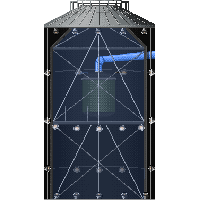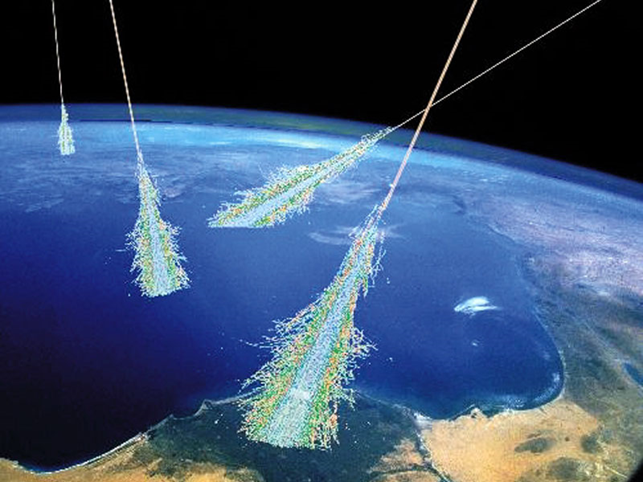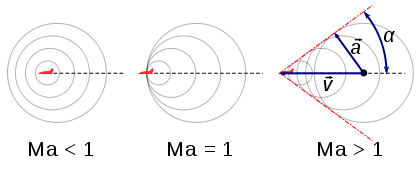
A water tank equipped with photomultipliers allows to subtract background signals in experiments that are searching for elusive particles.
The muon veto is used in different detectors searching for dark matter or solar neutrinos. It allows to tag and subsequently remove signals due to muons, penetrating particles produced by cosmic rays. The veto uses a physical phenomenon based on the emission of light track when the muons pass through ultra pure water. The emitted light is detected by photomultipliers and the signals are sent to an acquisition system for further analysis.
Cosmic rays are high-energy particles and atomic nuclei from space which at a speed very close to the speed of light hit atoms and molecules of the Earth’s atmosphere. Most of them are protons (90%), He nuclei (9%), and the remaining part is made up of heavier nuclei (1%). The origin of cosmic rays is only partially known. The low energy components come from the Sun, while the ones with high energy are produced mainly in supernova explosions and in active galactic nuclei. The energy of cosmic rays vary greatly with a range up to fourteen orders of magnitude. The most energetic cosmic ray ever measured (nicknamed “Oh my God particle”) had an energy 40 million times higher than the one of the particles in Large Hadron Collider (see Accellerator) . Anyway, the vast majority of cosmic rays have a much lower energy. When cosmic rays (primary) hit high atmosphere they interact with atoms and molecules in the air producing showers of new particles named secondary cosmic rays (Fig1). The secondary cosmic rays make their way down to the Earth’s surface. About 70% of the secondary rays are muons which are the most penetrating subatomic particles, capable of passing through large amounts of material.

Fig. 1. Artistic view of cosmic ray showers produced by the interactions of primary cosmic rays with the Earth’s atmosphere
Muons are the primary source of background disturbance for low counting experiments, such as those looking for neutrinos or dark matter. This is why underground laboratories are needed for this type of experiments. The overlying rock offers an efficient shield against the cosmic rays. In fact, the LNGS (Laboratori Nazionali del Gran Sasso) with a rock layer of 1400 m provides a muon flux reduction, in its underground site, of more than one million times compared to the surface. Often, this attenuation is not enough so many experiments further shield their apparatus with detectors which detect the residual muon flux. The muon veto in the XENON1T experiment appears like a big water tank, instrumented with light detectors (photomultipliers) which serve to detect the Cherenkov radiation always emitted by a charged particle travelling in a dense medium with a speed higher than the speed of light in that medium. The Cherenkov light beam looks like a cone around the particle trajectory (Fig. 2). This phenomenon is very similar to the sound shock wave produced by an aircraft exceeding the speed of sound in the air. It can be seen as due to the source of light moving faster than radiation and so generating an accumulation of front waves which create the electromagnetic shocks going under the name of Cherenkov light.

Fig. 2. Schema of the sound waves produced by an aircraft. When it exceeds the speed of sound (Ma>1) a cone of sound waves is produced. The phenomenon of Cherenkov radiation for charged particles is similar. Ma is the Mach number which is the ratio between the speed of an object in a fluid and the speed of sound in the same fluid.
The speed of light, like the speed of sound, changes according to the medium in which it is propagating. The speed of light has its maximum value in a vacuum which is actually an absolute limit that no physics phenomenon can violate. However, fast particles can move in a medium with a speed exceeding the one of light in that medium. This is the case with cosmic ray muons when they pass through water, and so they generate Cherenkov radiation in water. Thus, when muons pass through the muon veto detector the light cone generated in water is detected by photomultipliers which convert the light pulse into an electric signal. Occasionally muons can generate secondary particles in the water which penetrate in the dark matter detector. In this case there will be a coincident signal in the two detectors and so the event will be rejected as not due to dark matter. The internal walls of the tank are covered with reflecting foils which serve to increase the light collection capability. In experiments where light directionality matters, which is not our case, the reflectors cannot be used otherwise the directional information is destroyed by multiple reflections.
A muon is an unstable particle which decays producing daughter particles. The lifetime of the muon (i.e. the mean time it takes before it decays) is 2.2 μs (1 μs is 10-6 seconds). Assuming the muon travels at the speed of light (300000 km/s in vacuum) it turns out it would travel only 600 m in average before it decays. But muons are produced in the atmosphere, at more than 10 km in height, so how can they reach the Earth’s surface? This is possible thanks to the time dilation foreseen in Einstein’s Special Relativity. This theory says that time flows differently in reference systems travelling at different speeds. If hypothetically we travelled standing on the muon (zero relative speed) we would measure its lifetime as being 2.2 μs. But since it travels with respect to us with a speed close the speed of light its lifetime is increased by a factor that can be calculated with the equations of Special Relativity. The greater the velocity of the muons, the greater the time dilation effect. This explains why muons have enough time to travel all the way from the upper atmosphere to the Earth’s surface. Changing the reference frame to that of the muon, it is the distance from the upper atmosphere to the Earth’s surface that is contracted, thus the muon can reach the Earth and there is no contradiction in the final result.

Discover the experiments and help the alien to get back home!
Play now